Table of Contents [show]
Spinfuel Choice Award 2013 – 2016
The Spinfuel Choice Award has become a coveted award for many eliquid vendors. That said, we hear from a lot of people that want to know “what does the award really mean?”. This article will, hopefully, explain what it means and how it has changed since we first began awarding certain eliquid ‘flavors’ with the Choice Award in early 2013. To do so, we must go back to the early days and progress to the present.
When Spinfuel eMagazine began publishing way back in February 2012 the eliquid marketplace was very different than it is today. Back then the majority of eliquids came from mostly two sources, China and home-grown. (Notwithstanding companies like Johnson Creek)
China isn’t exactly a trusted source for foodstuffs, both human and animal, and it was apparent to us in 2012 that any Chinese eliquid, including the once dominant Dekang would easily place profit over quality. This proved to be true to the Spinfuel eLiquid Review Team after vaping more than a dozen flavors made by Dekang.
Whether or not you enjoyed, or still enjoy, Dekang eliquids, we made the decision not to consider a Chinese eliquid eligible for a Spinfuel Choice Award when we launched them in early 2013. Only eliquids made in the USA were eligible then, and today eliquids made in the USA and Western Europe are eligible.
Quality is Everything?
Let’s go back to 2012-2013 in order to explain why the Spinfuel Choice Award was launched.
The Vaping Industry was barely walking upright in 2012, despite being around since 2007. It was about to explode into the huge industry it is today despite the various methods small eliquid companies were using to produce their products. Let’s review a few of the then-well-known eliquid brands (no names mentioned) and their everyday practices.
Kitchen or Bathroom Made eLiquids
Would it surprise you to know that just a few years ago some of the biggest names in the industry were creating, mixing, bottling, labeling, and shipping their products in an apartment kitchen or bathroom, or garage? Well, it’s true. In fact, there are still some companies doing it this way, some with names you would instantly recognize.
The vaping community was, and remains, a tight-knit group. It was all about mechanical mods and homemade eliquids back then, and soon after the variable voltage battery. Creative and hardworking people learned how to mix the proper ingredients together to create eliquid, and as they shared their creations with friends and co-workers their reputation grew, locally at first, and then online in various vaping forums.
The homegrown, homemade eliquids became so popular online that people were buying more eliquid than the creative ‘maker’ could provide. When that happens its time to hire a few friends and launch a company.
At the time owners and employees volunteered this information, and sent us photographs of their so-called mixing areas which doubled as the bottling room, labeling, and of course, packing and shipping. We were horrified, but others never blinked because they understood that this was the way it worked.
But here’s the thing; the staff here at Spinfuel were not members of the vaping community for any real length of time when we first launched.
It took 6 months to launch Spinfuel, and that was exactly how long any of us were vaping. We did not know, or understand, the eliquid segment back on Day One, but we studied it, and by February 1st we had a basic understanding of the process.
Using What We Learned
After a few dozen cig-alike reviews we published during the first few months of 2012, and being fully aware that there existed at least a hundred cig-alike “affiliate” websites with their Top 10 list of the best ever cig-alike, arranged according to which company paid the highest commission, we made the decision to, in essence, reboot our publication when it was a mere 4 months old. We were, as we say, “doing it wrong”.
It was time to use the information we learned, to move away from the cig-alike, and leave that ugly segment of the industry to the bottom feeders.
During our reboot we removed most of the cig-alike reviews, leaving behind only a few of our hardest hitting reviews, leaving no doubt that the cig-alike was not the answer to quitting smoking, and that with only a couple of brands (Blu Cigs for one) even bothered to try and put out a decent product. That segment of the industry was filled with real estate investors, bankers, basically anyone wanting to grab a piece of profits from these worthless products and the cash they were generating.
The Team Review Concept
The truth about ‘most’ eliquids back in the day was no better than the truth about cig-alikes. Use the cheapest Propylene Glycol you can buy, the cheapest vegetable glycerin you can get, and purchase flavorings from the least expensive flavor house.
We purchased, and vaped, more than 20 brands “off the books” during late 2012 in order to develop our concept of a good eliquid. It took a while, but with a 5-member team (4 members today) we were able to agree on certain standards an eliquid company had to meet. Those standards have changed dramatically since then, and we’ll get that soon enough.
Early Standards
Moving away from the prefilled cartomizers of cig-alikes, we stocked up on 510-threaded “blank” cartomizers and we filled them with various brands and flavors. In the early days there needed to be a lot of PG in the formula in order to seep through the mostly unknown synthetic material stuffed inside and around the Kanthal coil.
Propylene Glycol is a thin liquid, and an irritant, but also capable of carrying the flavorings into the blended eliquid. PG is basically safe, though some people do have allergic reactions to it. It used in thousands of products, so most people don’t have a problem with it. We certainly didn’t have a problem with the stuff.
Using 80% PG and 20% VG eliquids we began to exploring the wide array of flavors in order to learn which flavorings worked best in an eliquid, which flavorings actually tasted like the name on the bottle, and the skill of the eliquid creator in developing a blend of flavors that were accurate to its intended flavor. But then…
We began to learn that there were several levels of quality to these ingredients. Who knew? We also learned that there were big differences in the quality of the different flavoring companies. Whereas all the cig-alike hardware was pulled from a catalog of batteries and cartomizers, eliquid was infinitely more complicated.
Our “team guidelines” served us well when we would experience new eliquids, and the more we experienced the more we were able to discern good from bad, cheap from not-so-cheap, authentic flavors and artificially enhanced flavors that reeked with chemical aftertastes. We were becoming connoisseurs of eliquid, and our recommendations to friends and other vapers were becoming a trusted source.
2013 – The Birth of the Spinfuel Choice Award
Armed with enough experience to know the complexities of an eliquid, to understand the flavor profile and how it was achieved, and to be able to detect the artifacts left from cheap PG and/or VG, we felt confident enough to begin to call out those brands and individual flavors that the entire team felt delivered what was promised by the company, and to inform our readers about them.
The Spinfuel Choice of 2013 was based on the infinite levels of quality that various brands were using. Some brands were purchasing the cheapest ingredients they could find and the end result was a chemical aftertaste and a very inauthentic taste. Flavors from certain batches tasted like one thing, other batches tasted like something else. Even nicotine brands varied, and the nicotine strengths were all over the place. Consistency was a big problem in 2013.
And some brands were buying the best ingredients they could find, and were spending a long time developing a formula for their flavors that were always consistent. These companies made eliquid that always tasted the same from batch to batch, bottle to bottle, and their nicotine strengths were consistent as well. These companies, and these eliquids needed to be recognized, their names shouted from the rooftops, they were making the industry better by putting quality above profit. A new concept for industry back then. So, these brands and flavors were given the Spinfuel Choice Award for excellence in eliquid artistry.
2014 – Advancing the Spinfuel Choice Award
In 2014, with plenty of Choice Awards given out the previous year, we had to try and change the environments of where much of the eliquids were still being created in. We could no longer tolerate even the highest quality eliquid brands IF these same eliquids were being created in kitchens, in industrial park office spaces, or other non-sterile environments where contamination could become a serious issue.
 In addition, the bottling practices had to change as well. We can’t tell you how many brands of eliquids that were submitted for review in 2013 and early-2014 whose caps were wrapped in electrical tape and nothing more. Labeling consisted of nothing more than the name of the flavor, the nicotine strength, and a brand logo. There needed to be more.
In addition, the bottling practices had to change as well. We can’t tell you how many brands of eliquids that were submitted for review in 2013 and early-2014 whose caps were wrapped in electrical tape and nothing more. Labeling consisted of nothing more than the name of the flavor, the nicotine strength, and a brand logo. There needed to be more.
In 2014 our own guidelines that permitted us to grant a Choice Award had to evolve, it had to include proper sterile rooms, shrink-wrapped bottles, and information rich labels. If they did not have these things, then no matter how good the eliquid performed in flavor authenticity and vapor production, they could not be awarded a Spinfuel Choice Award that year. The Spinfuel Choice Awards of the Year for 2014 were announced.
Liars, Lies and Damned Lies
In mid-2014 we began to suspect that our official “Submission Guidelines” PDF that we send to companies wanting us to review their eliquid line were telling us things that were not true.
We insisted that any eliquid sent in for review had to be made in a sterile environment, bottling, shipping, and all the rest had to occur in different rooms, and that people that to where specific clothing to restrict contamination. Brand owners told us they met all the requirements, when in fact they did not. One company in specific were so far off from the guidelines that we had to pull the review for fear that we could be libel if someone purchased eliquid from them and got sick, or worse.
2015 – The Spinfuel Choice Award Evolves Again
In 2015 our guidelines were mostly the same as 2014, but we added the “option” of submitting photographic evidence of where the eliquids we made, bottled, and shipped.
Because it was optional we received emails from most of the brands telling us that they did not want to reveal information that could be used by competitors. For a while we agreed, and with their promises that their eliquids were  created in Lab-like conditions, and that there were separate areas in the facility for bottling and shipping, we continued reviewing them.
created in Lab-like conditions, and that there were separate areas in the facility for bottling and shipping, we continued reviewing them.
Also that year not a single brand submitted eliquid that was not shrink-wrapped, most were even using safety caps, and most were also child resistant. Quite frankly, we tended to believe that such companies were complying with safe manufacturing procedures because they had done so much to make their bottles safe and provide information on the labels. But how much of this information was accurate? I don’t think we will every really know.
That year, 2015, the elements, or components, that would allow an eliquid to be awarded the Spinfuel Choice Award included:
-
Quality Ingredients
-
Safe packaging
-
Authentic, non-chemical flavors
-
Accurate Flavor Descriptions
-
Consistent flavors batch after batch
In the latter half of 2015 we added another requirement to the Submission Guidelines. Where for 3 years we managed to spend 72 hours vaping eliquids submitted by the brand with a single 30mL bottle, we now required 4x 30mL bottles per flavor. While each of the 4-member team had a 30mL bottle to themselves, in practice all 4 members shared all 4 bottles, to test for consistency of nicotine and flavors.
Also in 2015, we began granting the Spinfuel Choice Award to more and more brands and flavors. The reason being that all the brands were finally paying attention to the market, and our guidelines, and the only companies that sent eliquid for review were those that could actually qualify. In 2015 the Spinfuel Choice Awards of the Year were announced.
The Move Toward High VG
This was the time that many new companies, and established companies, began producing eliquids with higher and higher VG ratios. Sub-Ohm vaping exploded on the scene and because vaping with sub-ohm coils required more power (wattage) the ingredients vaporized more efficiently, allowing for more flavor to be released, more vapor, and a more efficient nicotine delivery.
Higher VG eliquids allowed the team to lower our nicotine strengths to just 3mg, from a high of 18mg. The high VG also vaporized faster, so by the end of the 72-hour review period we seldom had enough eliquid to last. And we certainly rarely had enough to vape during our “discussion” period, when we went through each eliquid flavor to see what the other members thought of them. Our individual scores, 1 to 5 stars, were always cast in secret, but our likes and dislikes were openly discussed.
As it turns out, 2015 become a Golden Age for eLiquids. Finally, eliquid creators figured out the holy grail, they learned how to get the most out of the high quality ingredients, and as a team we discovered so many delicious new eliquids. A glorious year, and many Spinfuel Choice Awards.
The Spinfuel Choice Award in 2016
Faced with such high quality eliquids, eliquids that tasted so good, that produced huge amounts of vapor, eliquids that were so damned satisfying, how can we keep the Spinfuel Choice Award special? If all the eliquids we review are great eliquids, why continue with the Award? How special is an eliquid when every brand has adopted good manufacturing policies, and are accurately describing their flavor profiles?
 Since the beginning of the Spinfuel Choice Award we made a point that an award cannot, should not, be based on whether or not a member of the team likes the actual flavor. To do that would kill any chance of a great Kiwi or Pomegranate eliquid from ever winning a Choice Award because there will never be a unanimous vote on certain flavors. Clearly it would be unfair to the brand, and to the readers that happen to enjoy flavors that the four of us do not enjoy.
Since the beginning of the Spinfuel Choice Award we made a point that an award cannot, should not, be based on whether or not a member of the team likes the actual flavor. To do that would kill any chance of a great Kiwi or Pomegranate eliquid from ever winning a Choice Award because there will never be a unanimous vote on certain flavors. Clearly it would be unfair to the brand, and to the readers that happen to enjoy flavors that the four of us do not enjoy.
In the above paragraph, when I talk about not liking certain flavors I do not mean certain flavor blends. If I did not like the flavor of Kiwi, then the chances that I would give any blend that includes Kiwi the full 5 points is very possible. If the brands tell us that the eliquid is a Kiwi and Strawberry smoothie, and it does in fact taste like a Kiwi and Strawberry smoothie then it will receive the full score.
In 2016 we will continue to insist that individual flavors are not considered when deciding the “score” of an eliquid. Instead, we will keep our current requirements, and add another… photographs.
Submitting photographs is no longer an option. If the brand insists on not submitting photographs we may still agree to review them, but they will not be eligible for a Spinfuel Choice Award.
In order to win a Spinfuel Choice Award in 2016, all 4 members must agree that the eliquid:
-
Deliver a solid vape experience with authentic flavor and excellent vapor production.
-
The official flavor description written by the brand must be accurate.
-
Proper manufacturing procedures must be followed. If eliquids are made in-house, i.e., made by the brand and not outsourced, we must have photographic evidence of the sterile environment, separate bottling room, and separate shipping department. Photographs must include the bottles or jugs of the PG and VG showing the brand name. We won’t publish those photos, unless we’re given permission, but we must see the photographs to assure ourselves that the eliquids are made in lab-like conditions.
-
We must agree that all members would happily recommend that brand and flavor to all vapers.
-
NEW* We must deem an eliquid to be “FDA-Safe”, meaning that when regulations come, this brand or flavor must already meet strict guidelines that we see coming.
Since its inception we have worked hard to bring to our readers the best, most in-depth eliquid reviews that we are capable of. We will continue to do so. We believe that we perform the best eliquid reviews you can find.
FDA-Safe
With FDA regulations looming on the horizon we must take responsibility for any awards we give out. Delicious, vapor heavy eliquids are themselves not indicative to meeting any FDA requirement. The Food and Drug Administration places requirements on all food manufacturing as well as drug manufacturing. To believe that the FDA will not set safe, strict requirements for eliquid manufacturing is to believe in fairies.
The move to FDA-Safe eliquids should be in full force by now, by every eliquid creator in the USA. Because we believe that the FDA will require at least as much care and safety that they require by manufacturers of food and pharmaceuticals companies, eliquid manufacturers must be ready now. At least as it pertains to being designated as a contender for a Spinfuel Choice Award.
Julia Hartley-Barnes, Kiera Hartley-Barnes, Tom McBride, Jason Little, and John Manzione




